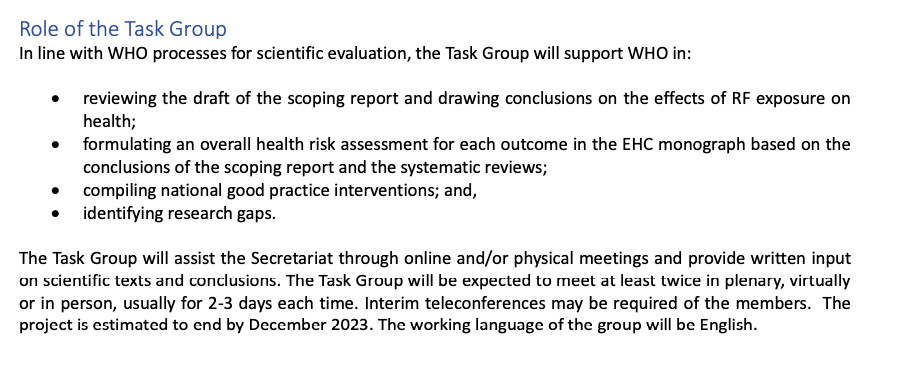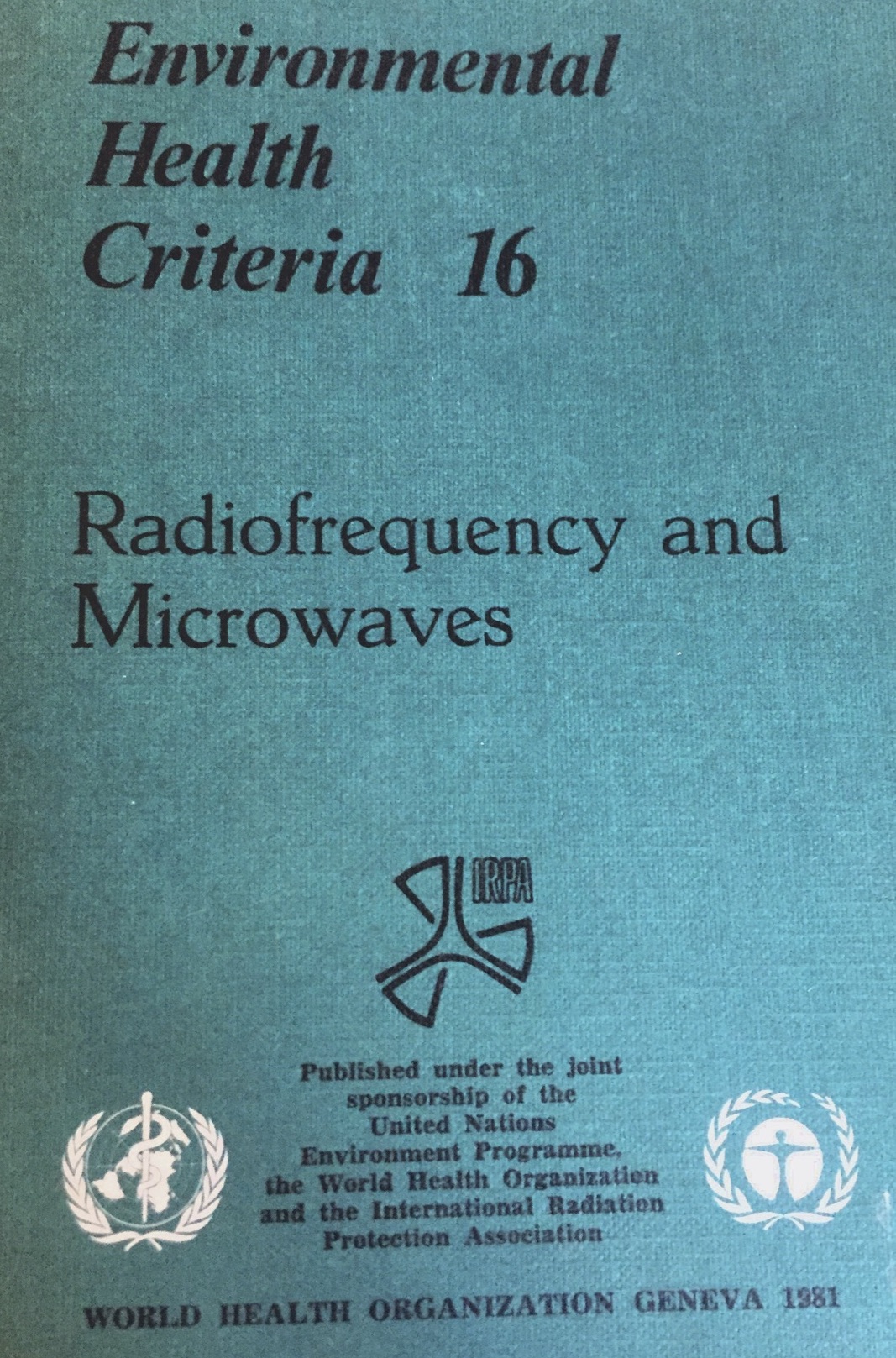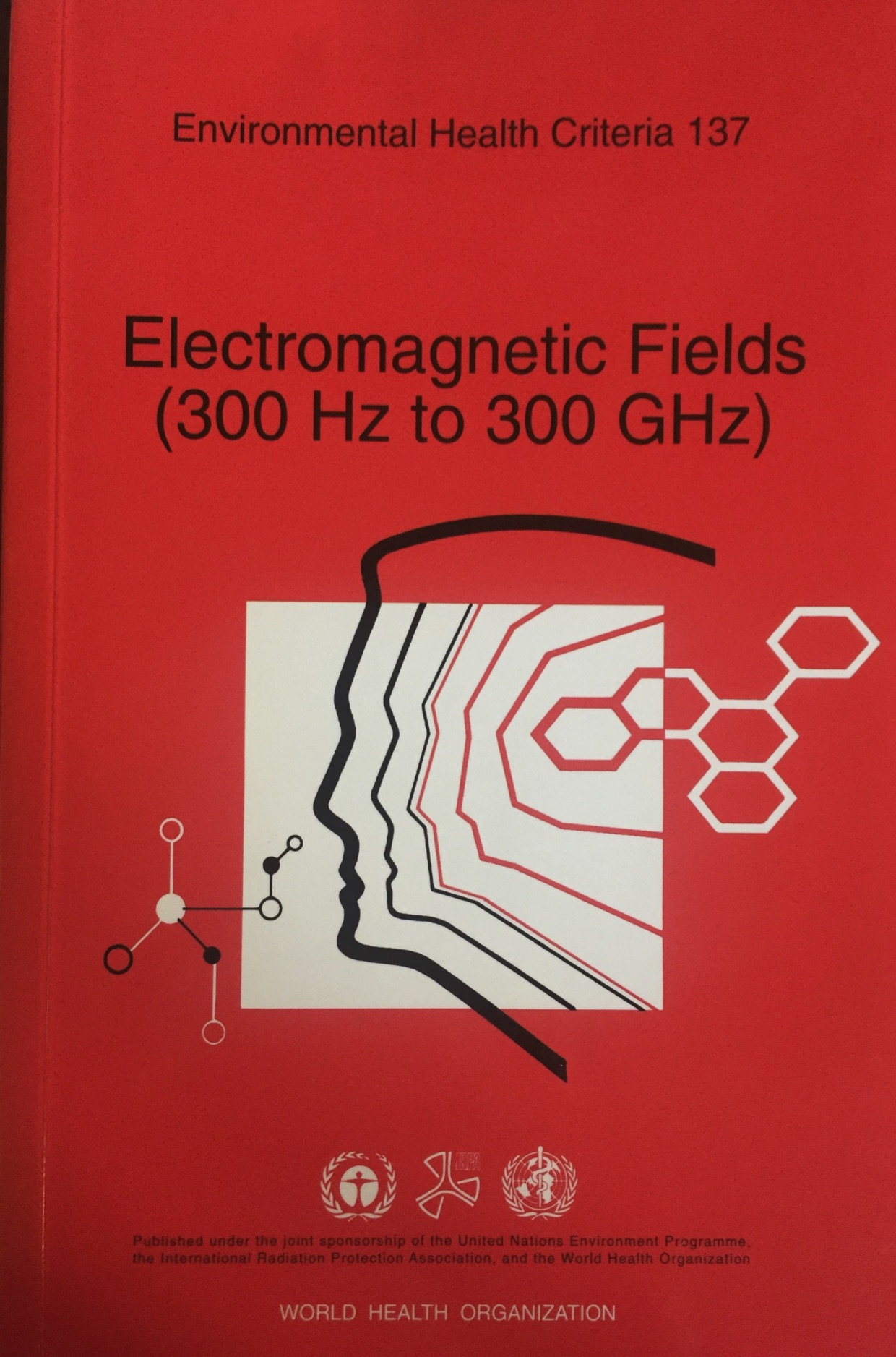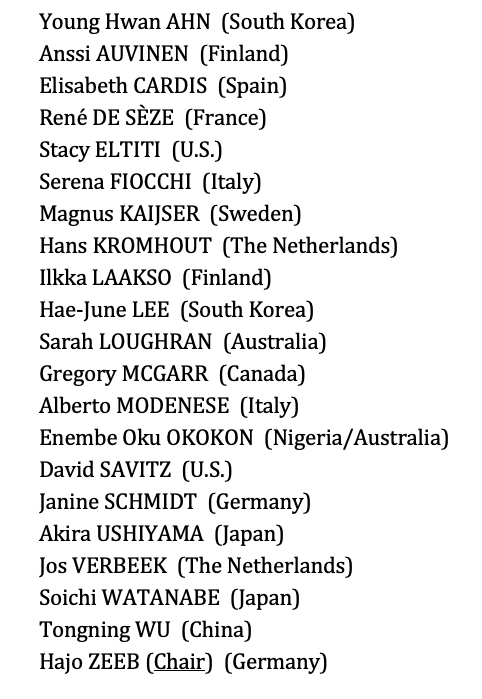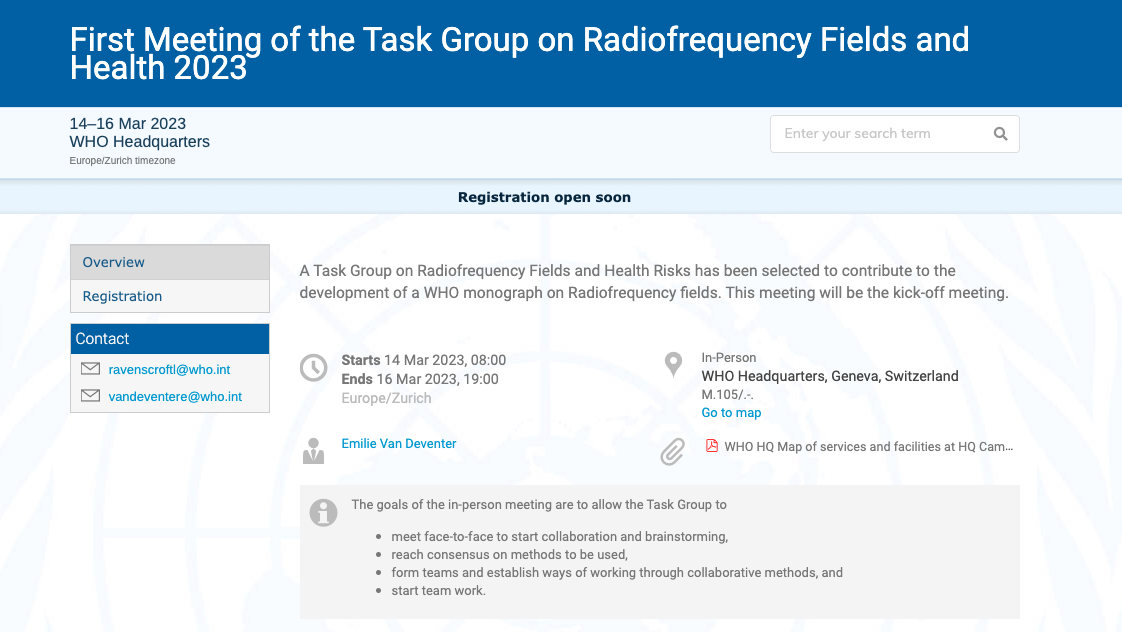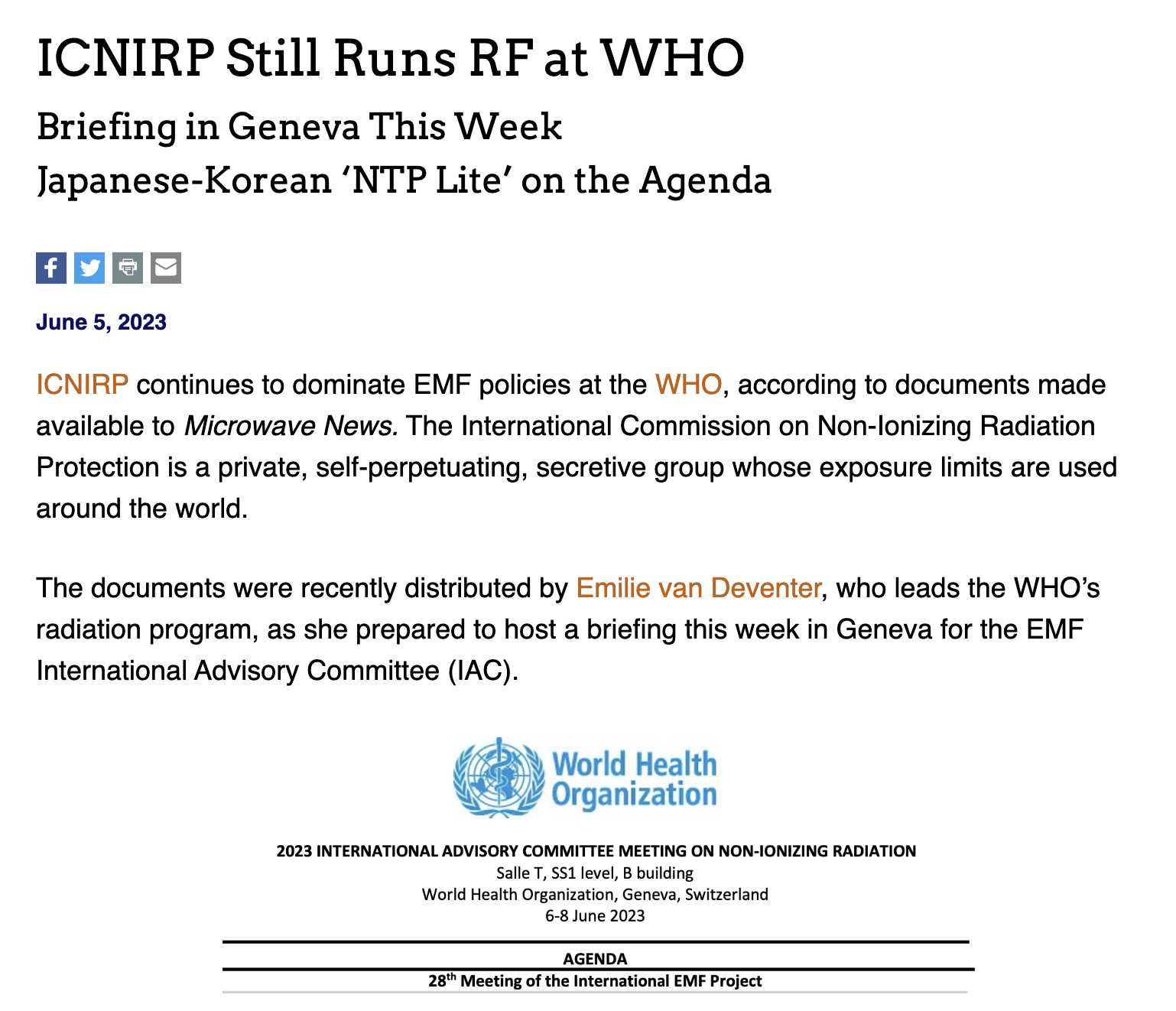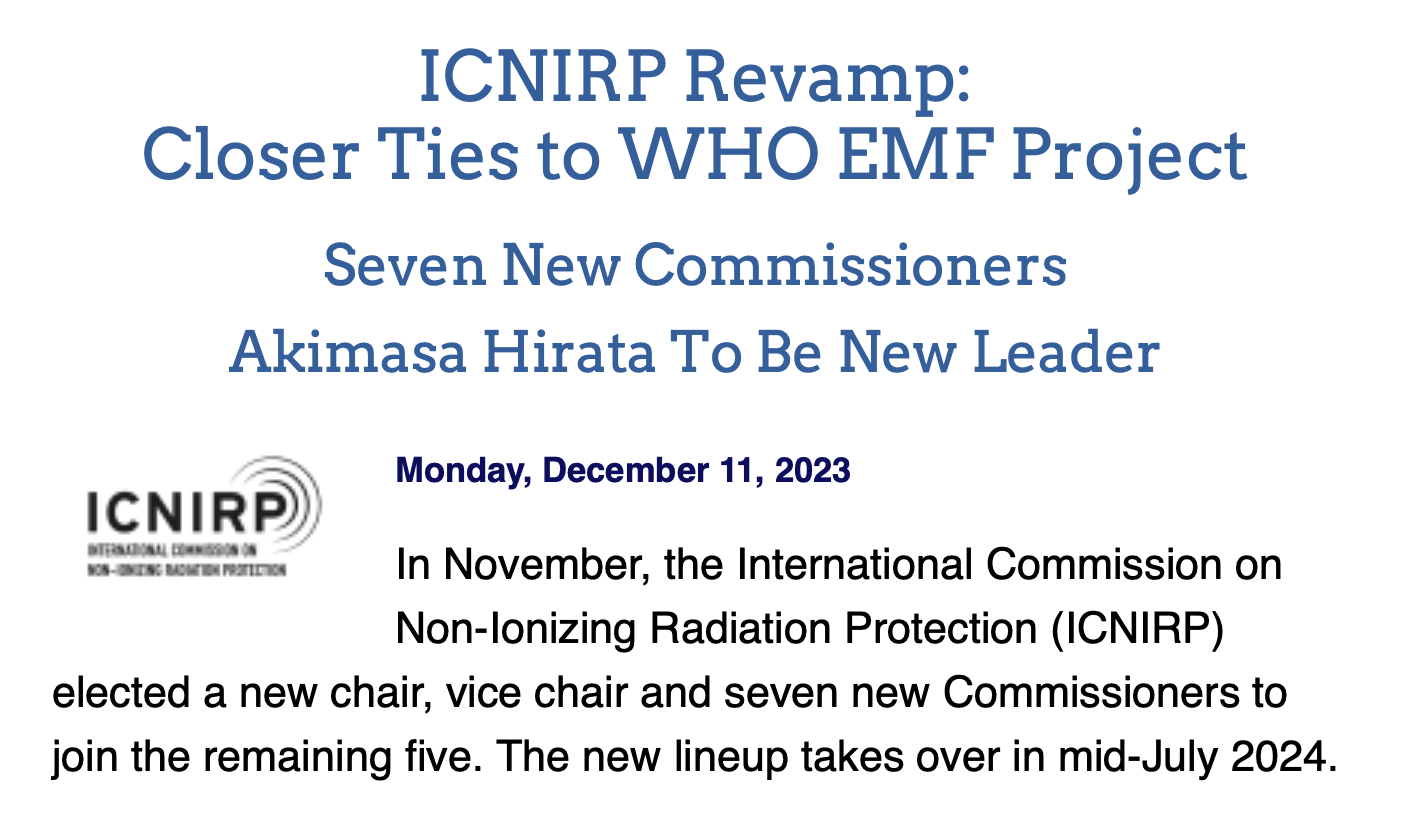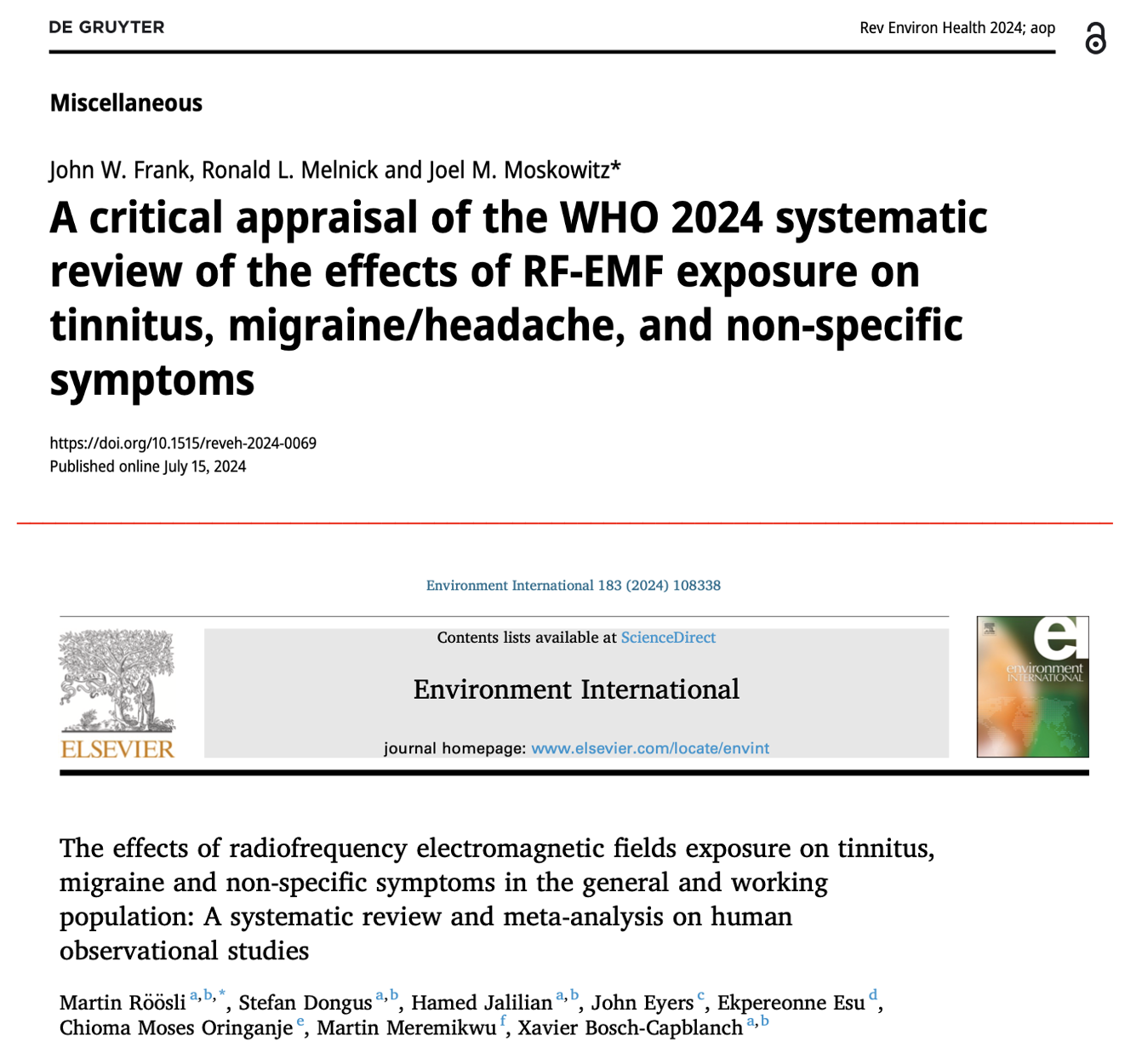Will WHO Kick
Its ICNIRP Habit?
Non-Thermal Effects Hang in the Balance
Repacholi’s Legacy of Industry Cronyism
[For the most recent updates on this continuing story, see “RF Review Shrouded in Secrecy,” (below) and “ICNIRP Still Runs RF at WHO”.]
After eight years of work, the World Health Organization (WHO) is reopening its review of the health effects of RF radiation for a summary report intended to serve as a benchmark for its more than 150 member countries. The report will be used as a guide to respond to widespread concerns over the new world of 5G.
The WHO issued a public call in October for detailed literature reviews on ten types of RF–health impacts from cancer to fertility to electrohypersensitivity. Some see the move as a sign that the health agency is interested in opinions beyond those of its long-time partner, the International Commission on Non-Ionizing Radiation Protection (ICNIRP). They hope that the WHO is finally ready to recognize evidence of low-level effects, in particular the link between cell phones and cancer. Others are far from convinced.
The skeptics see the new reviews as little more than a ruse. They fear that the WHO is only going through the motions and will in the end stick with ICNIRP’s long-held position that there are no RF effects other than those caused by heating.
Tight Schedule for the Systematic Reviews
The RF report, formally known as an Environmental Health Criteria (EHC) monograph, was last updated in 1993, more than 25 years ago. The WHO Radiation Program, based in Geneva, started working on a revision in 2012 with a target completion date of 2016. Eleven chapters of the draft report were released for review in 2014, and work on a second draft got under way soon after public comments were received. After that the process stalled, and the RF EHC was stuck in limbo.
Then, in early October —after a long public silence— the WHO issued the call for those ten “systematic reviews.” Systematic review is a term of art —you can read about it in a WHO handbook that presents a step-by-step formula on how to develop a health guideline, such as an EHC. The short version is that a systematic review takes a lot of work. As someone who has completed a number of them put it, “It’s not a trivial matter.” Even responding to a call for a systematic review is not easy, he said.
Each team must include at least two individuals, and “geographical diversity” is encouraged. Teams for systematic reviews can have up to six members, sometimes more, according to the WHO handbook.
The WHO set a very tight schedule. Responses to the call for all ten reviews are due today, November 4. Applicants had less than a month to complete the paperwork —that is, if they heard about it right away. The call was not published anywhere or posted on the Internet. Rather, Emilie van Deventer, the team leader of the WHO radiation program, sent a notice to her mailing list. Though the call is dated September, no one I spoke to received it before October 8. Many heard about it second hand, as did I.
Van Deventer left out some of those best-placed to raise awareness of the call. Dariusz Leszczynski, a now-retired professor in Helsinki who was a member of the IARC RF–cancer assessment in 2011 and who runs a blog for the EMF/RF community, wasn’t on her list. “I learned of it by coincidence, surfing the Internet,” he told me. Leszczynski posted the WHO announcement on October 9 and was one of the first to publicize it. (He is not responding to the call.)
Also ignored was Joel Moskowitz, a researcher at the University of California, Berkeley, who writes another widely followed blog, Electromagnetic Radiation Safety. He, like Leszczynski, has been critical of ICNIRP’s thermal-only outlook.
“It’s very surprising that they set such a short deadline; it would discourage good, very busy people from participating,” said one long-time researcher, who may submit a proposal. “You can’t put an international team together overnight.”
(A ground rule: With a few exceptions, those interviewed about the WHO call asked for anonymity so that they could speak frankly without jeopardizing their chances of being selected.)
A Fast Pace, But No Money
The pace does not ease up after the November 4 deadline. WHO officials have less than a month to evaluate the applications and make their selections. Work on the ten reviews must begin no later than December 2, and completed manuscripts submitted to an open-access, peer-reviewed journal within twelve months.
One more thing: There’s practically no money for the reviewers. WHO states that “only a small contribution towards the operating costs” will be available. In an e-mail exchange, van Deventer would not disclose the budget, saying only that there would likely not be enough money “to cover the total amount needed for a systematic review.”
According to the WHO handbook, members of a systematic review team “should have no financial or non-financial conflict of interest.” All applicants must submit a detailed declaration of interests, including income from employment, grants, consulting and investments.
The call states that each declaration “will be assessed for conflict of interests.” No one, apparently, will be automatically disqualified based on apparent conflicts, as was the case for IARC’s RF review in 2011 (more here; IARC is an agency of the WHO).
Who Picks? Why the Rush?
Most everyone I contacted was wondering, who will select the “winners”? When I posed the question to van Deventer, she replied the “WHO Secretariat,” adding that “rigorous internal processes” would be followed.
Even after they are picked, the identity of the winners will not be immediately revealed. Van Deventer said that she is not planning to announce the selections when the decisions are made. At the latest, we may not know who is preparing the reviews until they appear in print.
The other question on peoples’ minds was, “Why the big rush?” After all, work on the RF EHC began back in 2012; another month or two to give applicants more time would hardly make a difference.
In fact, EMF managers at the WHO knew years ago that systematic reviews would be required. That was part of new procedures for writing such documents, as set out in the WHO handbook. All van Deventer had to do was issue the call. She laid out what had to be done at an EMF Project advisory committee meeting in Geneva in late June 2017. She estimated that 15 reviews would be needed at a cost of $10-15,000 each. And, crucially, they “must be commissioned externally.” Even then, however, she did not have any money to pay for the reviews.
Over the last year, van Deventer has regularly briefed the International Telecommunications Union on the RF EHC. The ITU, which is also part of the UN, is a public-private partnership with many government and corporate members. In each talk, van Deventer said that the WHO would go ahead to “review, revise and update the 2014 draft.” In May of this year, she told the ITU that she would commission eight systematic reviews (see slide1 below); the list was later expanded to ten.
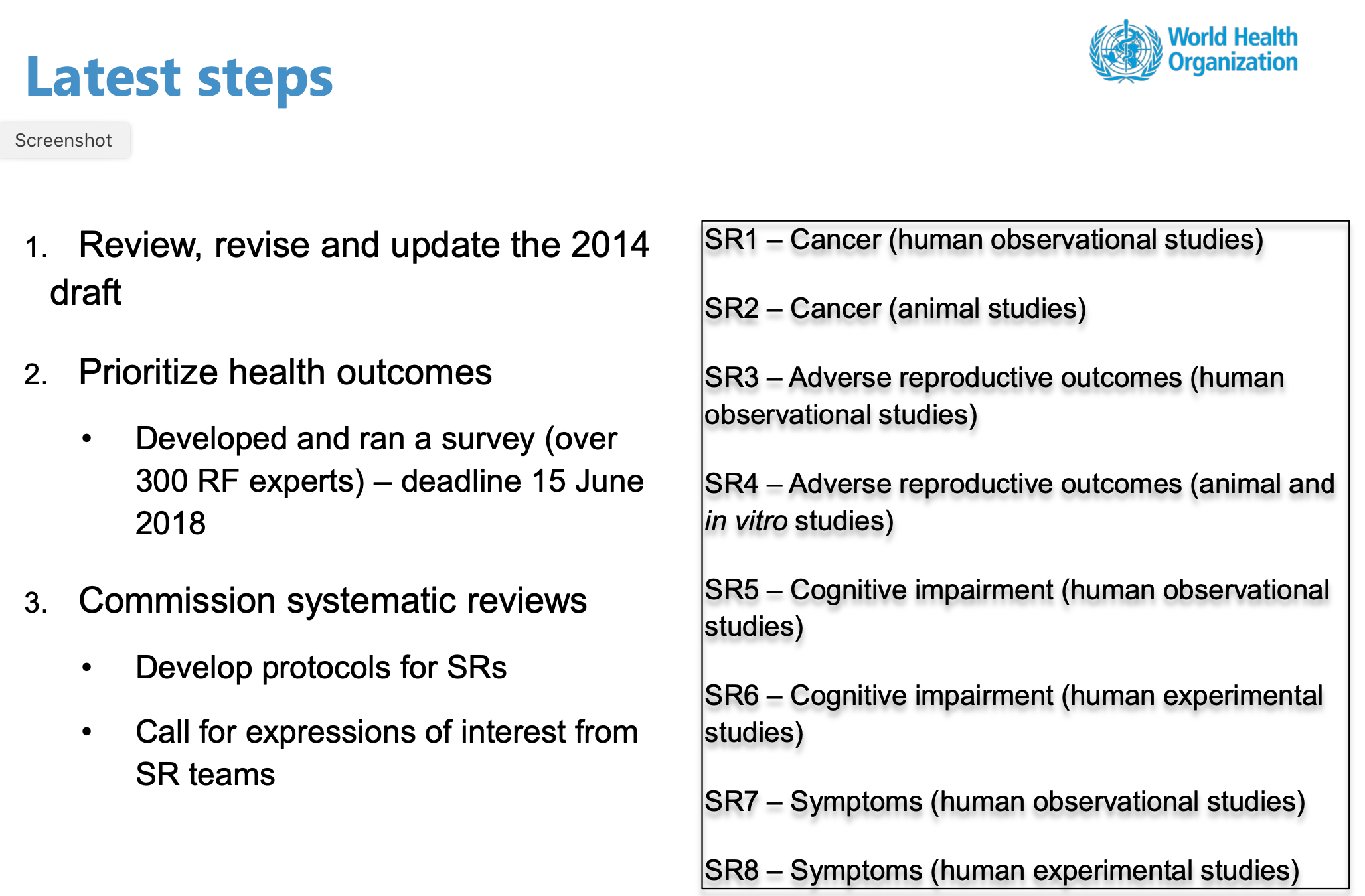
Slide No.25, E. van Deventer presentation to the ITU, most likely on May 20, 2019*
A few days earlier at the same ITU meeting, the Mobile and Wireless Forum, a trade association formerly known as the Mobile Manufacturers Forum, was invited to give a presentation on “Preparing for 5G: Research Relating to RF Exposure.”
E-mail traffic, shared with Microwave News, shows that van Deventer’s briefings were well circulated among ITU’s corporate members who follow the health question.
If van Deventer knew years ago that systematic reviews were needed, why did she wait until now to issue the call and then allow less than a month for replies? I asked her but she did not answer. I also asked the WHO press office to explain the rush. No one there replied or even acknowledged the request.
Also, why were telecom managers better briefed on the pending reviews than those in the health sciences who would be doing them?
Is the Call Rigged To Favor ICNIRP?
The lack of advance notice and the fast deadline have led some to question whether the WHO engineered the schedule to help ICNIRP stay in control. “I suspect that at least some have already been pre-selected to do the reviews,” said one European observer. “Even though it might seem to be an open and balanced approach,” commented another seasoned veteran, “I’m not convinced that in the end they won’t choose ICNIRP and Co.”
ICNIRP members would be well prepared to respond to the calls. They have recently finished their own literature reviews to update ICNIRP’s exposure guidelines, issued in 1998.
“The RF guidelines are now in press and publication is expected before the end of the year,” Eric van Rongen, the chairman of ICNIRP, told me in an e-mail exchange. In a presentation last April in Paris, van Rongen revealed that the exposure guidelines would continue to be based exclusively on thermal effects. There is “no evidence that RF EMF causes such diseases as cancer,” he said. Van Rongen is with the Health Council of the Netherlands.
Two important reviews by ICNIRP members have recently been published: one on epidemiological studies and the other on the NTP and Ramazzini animal studies. As von Rongen reaffirmed, neither indicates any movement towards accepting even the possibility of a RF–cancer risk.
WHO and ICNIRP’s Long, Intimate Association
From the very beginning, the WHO EMF Project and ICNIRP have been intertwined. This is not surprising since Michael Repacholi, an Australian biophysicist turned bureaucrat, was instrumental in setting up both organizations, ICNIRP in 1992 and the EMF Project four years later. (His bio is here, there’s a lot more below.)
From the very beginning, the EMF Project relied on ICNIRP for its scientific expertise, or in UN-speak, to serve as its scientific secretariat. In 2005, seven years before work on revising the RF EHC began, the WHO commissioned ICNIRP to do a review of the RF health literature, and Repacholi announced that the review would “serve as an input” for the RF EHC. It was completed in 2008.
Rick Saunders and van Rongen, then an ICNIRP member and advisor, respectively, were asked to help the WHO guide the EHC “to its completion.”
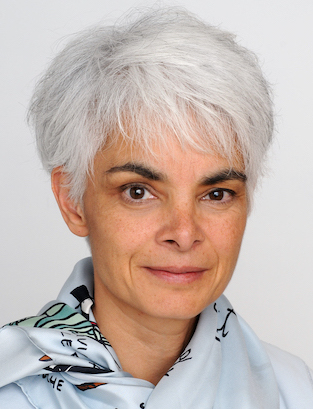

WHO’s Emilie van Deventer ICNIRP’s Eric van Rongen
Work on the RF EHC formally began at a meeting in Geneva in January 2012. The EHC would be based in part on ICNIRP’s literature review, according to the EMF Project’s 2012-2013 annual report. A “core group” was established to help develop the EHC. Five of its six members2 had close ties to ICNIRP. Van Rongen, who by then had joined the Commission, was in the core group. (He became the chairman of ICNIRP in May 2016.)
That core group, with the help of a couple dozen advisers, drafted the 11 chapters that were released for public comment in 2014.
A Contentious Meeting in Geneva
The draft got a stormy reception. There were 686 comments in all, and a good many criticized the WHO for discounting low-level, non-thermal effects. The WHO has not released the comments, preventing a count of pros and cons.
Later, in a widely circulated letter sent to Maria Neira, the WHO executive in charge, Oleg Grigoriev, the chairman of the Russian national non-ionizing radiation committee, complained that the core group that drafted the report was “not balanced and [did] not represent the point of view of [a] majority [of the] scientific community studying [the] effects of RF.” He and others were disappointed that the WHO had failed to go beyond the heat-only dogma embraced by ICNIRP.
On March 3, 2017, at about the same time that Grigoriev’s letter landed on Neira’s desk in Geneva, she and van Deventer hosted a five-member delegation from the European Cancer and Environment Research Institute. They were there to deliver the same message: The RF EHC should include low-level effects.
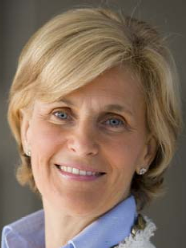
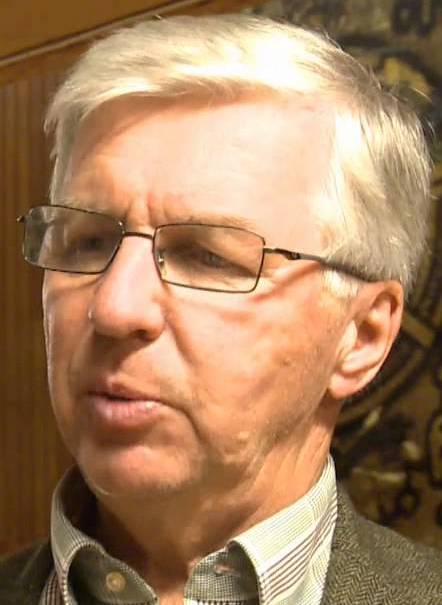
Maria Neira Lennart Hardell
The meeting did not go well. Neira rebuffed their overture and rejected any type of collaboration. She went on to tell them that they should not expect any future meetings, according to a brief account by Sweden’s Lennart Hardell, a member of the ECERI delegation.3
Neira did not respond to a request for comment.
The five researchers went home and laid out their case in a paper that was published in the journal Environmental Pollution last year. This is their bottom line:
“It is urgent that national and international bodies, particularly the WHO, take this significant public health hazard seriously and make appropriate recommendations for protective measures to reduce exposures.”
After that, little more was said about the RF EHC document —at least in public— as van Deventer and others looked for a way to comply with the new WHO rules that required systematic reviews, compounded by an added protocol for working with non-government organizations (NGOs, for instance, ICNIRP). WHO’s Engagement with Non-State Actors, better known as FENSA, was issued in 2016.
These changes were raised at that same EMF Project advisory committee meeting held in June 2017, close to four months after Neira met with the non-thermalists. Van Deventer explained to the group that, “FENSA potentially makes co-publication of the [RF EHC monograph] with ICNIRP problematic.” She went on to explain:
″A[nother] question concerned cooperation with ICNIRP in the development of the EHC. The WHO Guideline Development process would permit this provided the required processes were followed. However, it is not clear whether this is possible with the introduction of the new FENSA.”
The minutes of the meeting show that an attendee, who is not named, warned: “There may be dangers in aligning WHO with ICNIRP and cooperating with them will not make the guidelines better.”
With van Deventer no longer responding to my e-mails, I turned to van Rongen. He told me that there had been discussion of the constraints of the new WHO rules for developing guidelines and working with NGOs, and then he added,
“[There] was concern on the personal involvement of several members of the Core Group who are also members of the Main Commission of ICNIRP (myself, Maria Feychting, Gunnhild Oftedal) and several other experts who are assisting the Core Group and who are either Commission members or members of the Scientific Expert Group of ICNIRP.”
Investigate Europe on WHO & ICNIRP
Last March, the WHO was pressured from a different direction: An international team of journalists, working under the banner “Investigate Europe,” published a series of articles in newspapers across the continent on the national and multinational groups that set EMF/RF policy. They focused on the WHO EMF Project and ICNIRP.
Investigate Europe put together an interactive graphic showing six key organizations (in green, with WHO and ICNIRP at the center, below) and their links to important players and sources of industry funding. Some of the journalists referred to ICNIRP as a “cartel.”
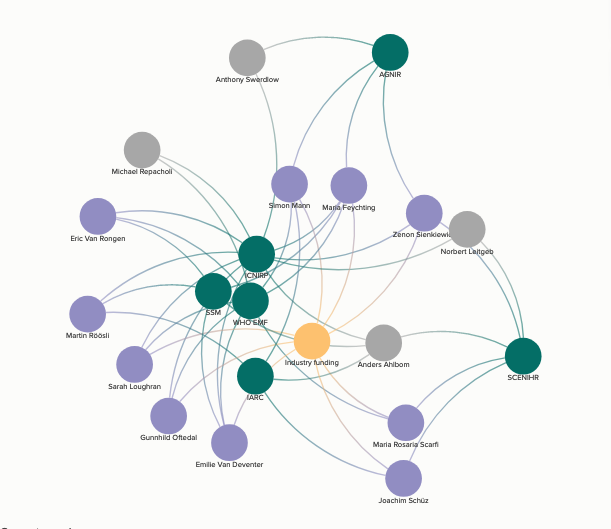 Source: Investigate Europe
Source: Investigate Europe
In an overview article, titled “How Much Is Safe?,” the team described how allegations of one-sidedness had “ravaged” the core group of ICNIRP insiders who drafted the chapters of the EHC report that were released in 2014.
When the journalists turned to the WHO for comment last December, a spokesperson “assured” them that the agency would put together a larger panel to “evaluate” the work of the original core group. The new participants would include “a broad spectrum of opinions and expertise,” according to the WHO.
The press office was referring to a Task Group that would take the draft chapters and complete the RF EHC. Despite years of being on the brink of appointing members, van Deventer has yet to assemble the group. Van Rongen told me that she has recently identified someone to chair it but he was not at liberty to reveal who it is.
WHO, ICNIRP & Michael Repacholi
Much of the suspicion over WHO’s handling of the RF EHC can be traced back to Michael Repacholi and his legacy of cronyism and favoritism to industry.
Repacholi, the former head of both the EMF Project and ICNIRP, was a leading player in the writing of WHO EHC reports on EMFs, at both high and low frequencies, for close to 30 years.
Back in 1981, while working for Health and Welfare Canada, he was on the committee that issued the first RF EHC (#16). An update (#137) came out in 1993 with Repacholi, who by then was back home in Australia, serving as the chairman of the panel. Three years later, he was in Geneva to open and run the EMF Project, where he stayed until he retired in 2006. Before he left, Repacholi shepherded an EHC report (#238) on ELF (power frequency) EMFs through the WHO bureaucracy.
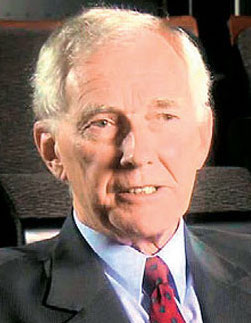
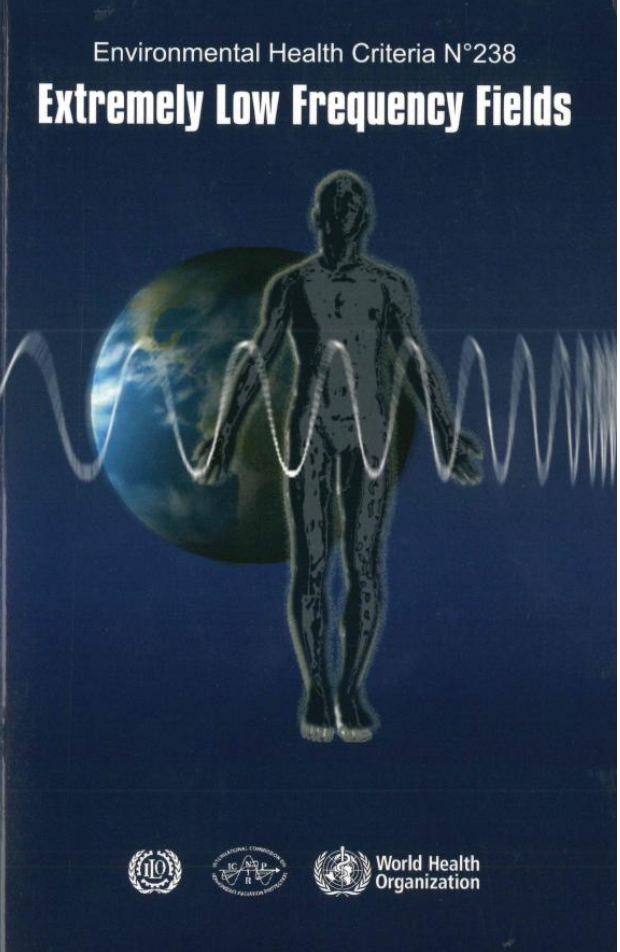
Michael Repacholi ELF EHC 2007
Financial disclosure was never a priority for Repacholi, and details of the WHO Project’s budget and funding were closely held. Even when the cell phone industry admitted that it was making annual, six-figure contributions to the WHO EMF project, Repacholi kept it all very hazy.
ICNIRP’s finances are no more transparent.
Repacholi retired from the WHO in 2006 and immediately became an industry consultant. On his first outing he was accused of misrepresenting the as-yet unreleased ELF EHC report for the benefit of his corporate clients. (See our story, his response and our reply.)
Later, stating that he wanted to “set the record straight,” Repacholi revealed that half of the WHO EMF Project funding had come from industry.
Taking money from Motorola and industry trade associations, among others, violated WHO rules. Repacholi found a work-around by passing —laundering— the money through the Royal Adelaide Hospital in Australia, where he had been chief scientist from 1983 to 1991. The WHO turned a blind eye and cashed the checks. Industry was rewarded with a seat at the WHO table.
One of the ironies of Repacholi’s career is that, in the mid-1990s, he led one of the first animal studies to link cell phone radiation to cancer. In stunning disregard for public health, Repacholi kept the results secret for two years, telling only Telstra, the Australian telecom giant that paid for the study. (Our write-up is here.) There have been two attempts to repeat the experiment, but both were botched, and his finding stands.
For more of the Repacholi story, follow the link to our roundup from 2005, WHO Watch: Mike Repacholi & the EMF Charade.
WHO Reopens Call for 3 Systematic Reviews
The WHO has relaunched its call for three of the ten systematic reviews of RF–health impacts it originally sought last fall:
1) Cancer (animal studies)
2) Adverse reproductive outcomes (animal & in vitro studies)
3) Effect of exposure to heat from any source on pain, burns, cataract and heat-related illnesses.
These calls have been reopened because the WHO did not “receive proposals that fulfilled all the qualifications and skills required, and in particular sufficient experience and expertise in conducting systematic reviews,” Emilie van Deventer told Microwave News.
Proposals are due by February 7.
The WHO has apparently selected the teams for the other seven RF reviews. No word yet on who they are.
Calls for Transparency
January 10, 2020
Today, Lennart Hardell asked the WHO leadership, including Director-General Tedros Adhanom Ghebreyesus, Maria Neira and Emilie van Deventer, for transparency in the systematic review process.
Specifically, he wrote:
“These main questions below need urgently to be answered by WHO and posted on the web:
1. Names of the persons in the evaluation group at WHO and any conflicts of interest in that group.
2. The scientific criteria applied in the selection process.
3. Presentation of all groups that applied for the different groups SR1 to SR10.
4. Which group was finally selected for each effect, any conflicts of interest within the group and scientific merits for each individual.”
Hardell’s letter follows a similar plea from a group of researchers4 in early December. They also asked van Deventer who had selected the review teams and what criteria had been used to evaluate them. This latter letter was coordinated by Theodora Scarato, the executive director of the Environmental Health Trust. No word back yet, she said in an email today.
Bids on Systematic Reviews
November 23, 2020
At an international briefing, known as GLORE 2020, WHO’s Emilie van Deventer offered details on the ten systematic reviews on RF health, commissioned last year. Details are here.
Selecting Health Topics for Systematic Reviews
December 20, 2020
A paper describing how the WHO picked the ten topics for systematic reviews has been published in the January 2021 issue of Environment International. Among the authors are Emilie van Deventer, Eric van Rongen and Maria Feychting.
Here are the main points:
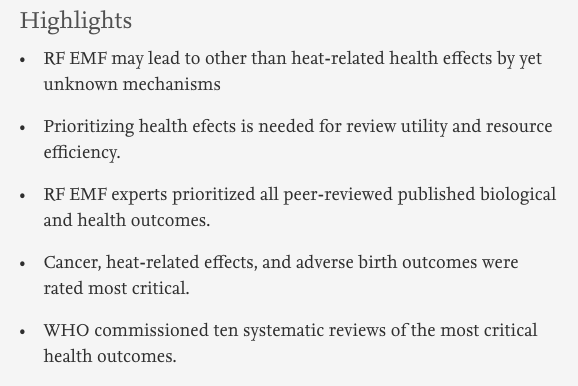
Cancer Review Has Strong ICNIRP Participation
August 22, 2021
A paper posted today reveals the team which was selected by the WHO for its systematic review of RF and cancer (human observational studies).
The paper is the protocol for the forthcoming review.
Ken Karipidis and Martin Röösli are current members of the ICNIRP Commission.
Maria Feychting served as a commissioner for 12 years before stepping down last year; for the last eight years of that run, she was the vice chair of ICNIRP. She is currently a member of two ICNIRP Scientific Expert Groups, one of which is on RF radiation. Röösli is a member of that same RF expert group.
Feychting & Röösli on 2nd Review
September 10, 2021
A newly published protocol for another of the WHO RF systematic reviews —on tinnitus, migraine and non-specific symptoms in the general and working population— shows that Maria Feychting and Martin Röösli are members of this team of reviewers too. The group includes researchers from Iran and Nigeria.
In a subsequent exchange on Twitter, Röösli acknowledged that he was a member of a third team working on another, as yet unspecified, RF systematic review.
WHO Issues Call for RF Experts
October 25, 2021
Emilie van Deventer, WHO’s radiation team leader, has issued a call for experts to help develop the long-delayed revision of its RF EHC document. The deadline is November 30, 2021.
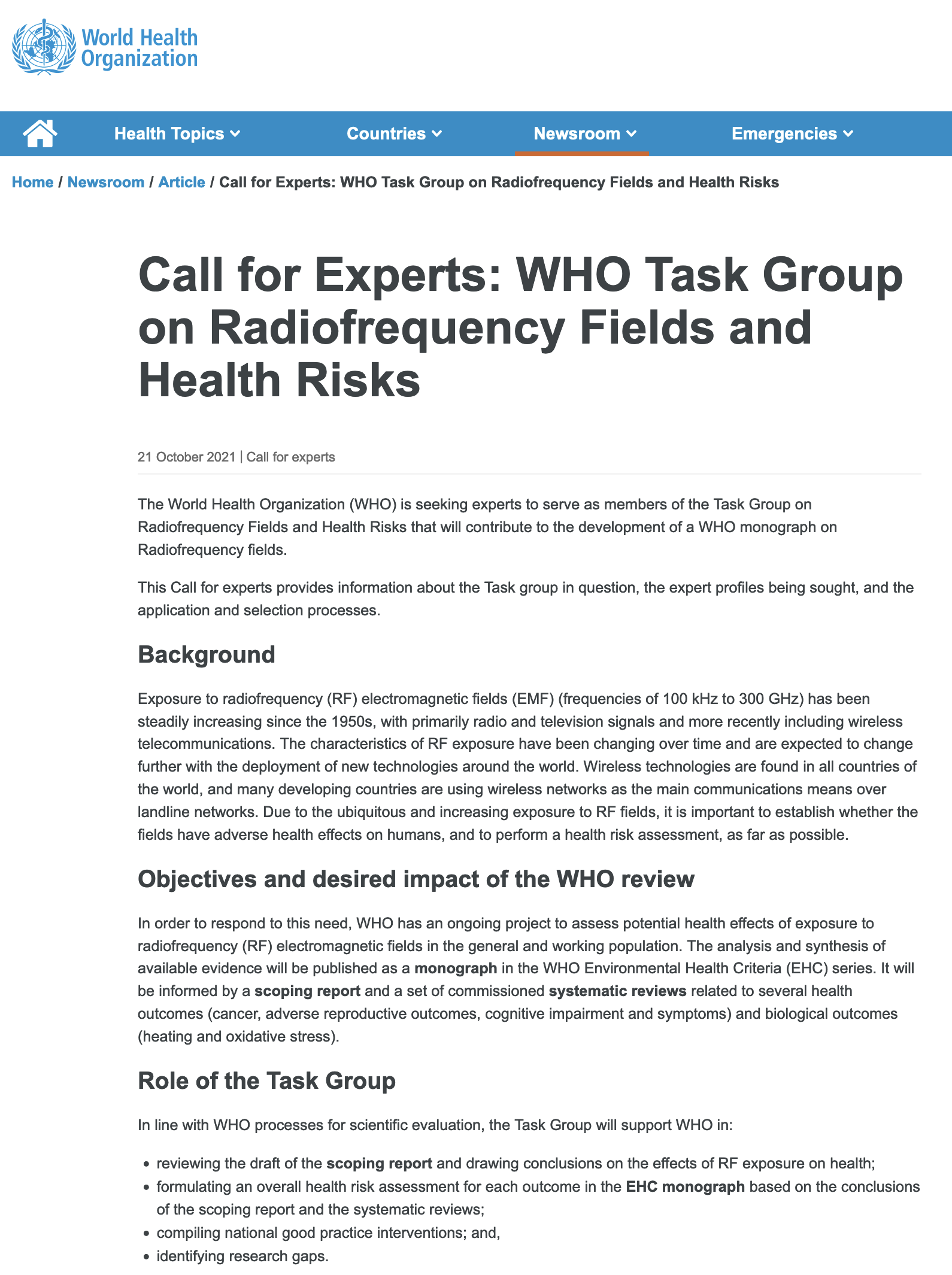
Van Deventer and the WHO bave free rein as to how the panel of experts will be selected and the whole process in general. The WHO advises in its press announcement:
Deadline for Call for RF Experts Extended
November 26, 2021
The WHO has pushed back the deadline for its call for RF experts until December 15.

Members of RF Working Group Named
December 15, 2022
The WHO EMF Project has released a list of 21 experts who will be appointed members of its RF radiation “Guideline Development Group.” They will help establish WHO’s policies on RF and health for years to come.5
The working group will guide the agency’s revision of its RF Environmental Health Criteria (EHC), a process that began over ten years ago. The document was last updated in 1993 (see above). WHO expects the group to finish its work by December 2023.
The proposed panel members are:
In its public notice, the WHO states that it is posting the list “in order to enhance its management of conflicts of interest as well as strengthen public trust and transparency in connection with WHO meetings.” WHO is inviting public comment (no deadline is given); submissions will be kept confidential.
The EMF Project has posted short biographies of the panelists, which, according to the WHO notice, were “provided by the experts themselves and [are] the sole responsibility of the individuals concerned.”
ICNIRP’s influence is hard to miss. Also striking is the absence of any EMF expert who, as one observer put it, is “not a member of the club.” For example, no one associated with ICBE-EMF, recently established as a counterweight to ICNIRP, is on the working group.
The provisional chairman of the working group is Hajo Zeeb, a professor of epidemiology at the Leibniz Institute in Bremen, Germany. In 2005, he started working at the WHO’s Department of Public Health and Environment in Geneva, focusing mainly on issues related to environmental radiation. In 2009, he was the lead author of the WHO Handbook on Indoor Radon.
Before joining the Bremen institute in 2010, Zeeb was a professor of epidemiology at the Institute of Medical Biostatistics, Epidemiology and Informatics at Mainz University Medical Center, which was led by Maria Blettner from 2003 to 2018.
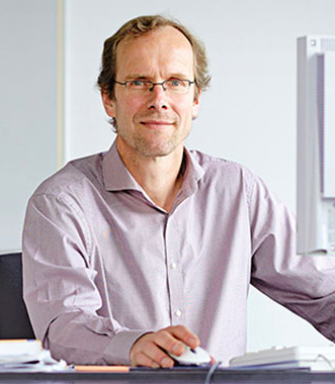
Hajo Zeeb
Blettner is an important figure in both the ionizing and non-ionizing radiation communities. She was a member of the SSK, Germany’s Commission on Radiation Protection, from 1998 to 2001, serving as its chair for the latter two years.
Blettner was the leader of the German Interphone group. Other members included Joachim Schüz, now at IARC, and Florence Samkange-Zeeb, who, like her husband Hajo Zeeb, came to the Leibniz Institute from Mainz in 2010.
The German researchers were among the first Interphone groups to publish their brain tumor results. In 2006, they reported a more than doubling of the incidence of glioma among those who had used mobile phones for ten years or more —an admittedly uncertain finding due to the small number of cases. “I can only say that it’s still an open question whether there is a tumor risk for more than ten years of use,” Schüz told me at the time. By then, Schüz had left Mainz for the Danish Cancer Society in Copenhagen. (He moved to IARC in 2010.)
That increased brain tumor risk was the key finding when the data from all 13 Interphone countries were combined. Still, Schüz and Blettner would emerge as leading skeptics of an RF-cancer risk (more here.)
Blettner was a member of the 2011 IARC RF working group and was the only one of the two dozen members to vote against classifying RF as a 2B, possible human carcinogen.
In 2009, Samkange-Zeeb, Schüz and Blettner criticized a South Korean-U.S. meta-analysis that supported an association between brain cancer and the long-term use of mobile phones. (Joel Moskowitz of UC Berkeley Public Health was one of the authors.) “In our opinion, this meta-analysis is an example of what happens when authors may have the technical skills of performing a meta-analysis, but are unfamiliar with the topic,” they wrote in a letter to the Journal of Clinical Oncology.
In a short tribute posted a few months ago by the American Journal of Epidemiology, Hajo Zeeb and members of the Mainz Institute hailed Blettner’s contributions to radiation epidemiology. “Her success was based on a strong network of collaborators and friends, including principal investigators of milestone studies such as John Boice, Maria Feychting and Elisabeth Cardis,” they wrote.
Links to ICNIRP
Five on the WHO list have direct links to ICNIRP. Soichi Watanabe is on the commission. Four others, Anssi Auvinen, Ilkka Laakso, Sarah Loughran and Tongning Wu, are members of ICNIRP’s Scientific Expert Group.
Loughran, who works at the Australian Radiation Protection and Nuclear Safety Agency (ARPANSA), is a long-time protégé of Rodney Croft, the chairman of ICNIRP. He was on her doctoral thesis committee at the Swinburne University of Technology in 2007 and they are now both at the Australian Centre for Electromagnetic Bioeffects Research (ACEBR), where Croft is the director.
Another ICNIRP connection is Janine Schmidt, a senior scientist at the Germany’s Federal Office of Radiation Protection, the BfS. It’s the principal sponsor of ICNIRP, providing about three-quarters of its annual budget. BfS’s Monika Asmuss was a Commissioner from 2016 to 2018. Some see ICNIRP as a subsidiary of the BfS.
David Savitz, an epidemiologist at Brown University, is one of two Americans slated to be on the working group. He is the chair of the non-ionizing radiation group at the National Council on Radiation Protection and Measurements (NCRP).
In late 2011, Savitz was a member of ICNIRP’s standing committee on epidemiology, which published a commentary titled, “Mobile Phones, Brain Tumors, and the Interphone Study: Where Are We Now?” It concluded, “Although there remains some uncertainty, the trend in the accumulating evidence is increasingly against the hypothesis that mobile phone use can cause brain tumors in adults.” Among his coauthors are Sweden’s Maria Feychting and the U.K.’s Anthony Swerdlow; both were ICNIRP commissioners at the time. The commentary, published in the November 2011 issue of Environmental Health Perspectives, came just five months after IARC’s classification of RF as a possible human carcinogen, based in large part on the Interphone project.
The other American is Stacy Eltiti, a psychologist at Biola University in Southern California. (Biola calls itself a “Christ-Centered University.”) Eltiti did her doctoral studies at the University of Essex in the U.K., where she investigated a possible association between exposure to base station radiation and self-reported symptoms of EM hypersensitivity (EHS). No link was seen.
Among the others nominated for the WHO group are:
• South Korea’s Young Hwan Ahn is a member of the Japanese-Korean project working on a small-scale repeat of the NTP animal study.
• Elisabeth Cardis of ISO Global in Barcelona was the leader of both the Interphone and MOBI-Kids projects.
• René de Sèze of the French National Institute for Industrial Environment and Risks (INERIS) is a former president of both the Bioelectromagnetics Society (BEMS) and the European BioElectromagnetics Association (EBEA). More here. Some years ago, de Sèze was a member of an ICNIRP subcommittee on biology.
• Magnus Kaijser is a consultant on neuroradiology at the Karolinska Hospital in Stockholm. He is also an adjunct professor of epidemiology at the Karolinska’s Institute of Environmental Medicine; the head of its epidemiology unit is Maria Feychting, who served as ICNIRP’s vice chair for eight years (2012-2020).
• Hans Kromhout, a professor at the University of Utrecht, was the chair of an advisory panel to the Health Council of the Netherlands, which recommended a “cautious approach” to 5G radiation exposures.
• Jos Verbeek of the Amsterdam Medical Center is the lead author of a survey of “experts” on RF health effects, published last year. Among his coauthors are Maria Feychting, Simon Mann, Gunnhild Oftedal, Maria Scarfi and Eric van Rongen, all current or former members of ICNIRP or its expert group. Emilie van Deventer, the head of the WHO EMF Project is also a coauthor.
RF Working Group Held 1st Meeting in March
—No Public Notice
April 8, 2023
The WHO held the first meeting of its RF Working Group on March 14-16 in Geneva. It was a hush hush affair.
Emilie van Deventer, who is leading the RF project, made no public announcement and as of this writing, nothing about it appears on the WHO website, except for this:
RF Review Shrouded in Secrecy
April 20, 2023
Following repeated requests, the WHO EMF Project has confirmed to Microwave News that its RF Working Group (aka RF Task Group) met March 14-16 in Geneva.
An email message from the project secretariat stated that all but one of the members of the panel were in Geneva for a face-to-face meeting to “establish ways of working and develop a workplan.” The sole exception was absent due to a scheduling conflict.
The roster of those selected to be on the Task Group is the same as the one announced by the WHO last December, with Hajo Zeeb, a professor of epidemiology at the Leibniz Institute in Bremen, Germany, as the chair (see above).
The project staff told me that I should expect no further details from either the WHO or from members of the Task Group: “Experts are not to communicate the deliberations and decisions of the advisory process to third parties,” the staff wrote in the email, adding that this policy is in accordance with “WHO rules.”
Were Task Group Members Proposed or Appointed?
In its December Public Notice, WHO stated that those on the list were being “considered” for membership. This is how WHO put it:
“In order to enhance its management of conflicts of interest as well as strengthen public trust and transparency in connection with WHO meetings and activities involving the provision of technical/normative advice, the names and brief biographies of individuals (“Published Information”) being considered for participation in a WHO-convened Guideline Development Group are disclosed for public notice and comment.”
But there are strong indications that the appointments were not being proposed but had already been decided: The Task Group was in fact already in place.
That’s what Sarah Loughran, a member of the Task Group, was saying back in December less than two weeks after WHO’s first announcement. Loughran is the director of EM energy programs at the Australian Radiation Protection and Nuclear Safety Agency (ARPANSA) and a long-time member of ICNIRP’s Scientific Expert Group. She joined the SEG in 2013, a year after Rodney Croft, her mentor, became a Commissioner. Croft is now the chairman of ICNIRP, and some see her as Croft’s alter ego on the Task Group.
In her Declaration of Personal Interests, filed with ICNIRP on December 27, 2022, and posted on the Commission’s website, Loughran disclosed her appointment to the WHO RF panel. In that same document, she noted that she has been working with the WHO on revising its RF Environmental Health Criteria document since 2012.
Loughran’s ICNIRP declaration also reveals that she serves as an unpaid advisor to the Australian Mobile Telecommunications Association (AMTA) and the GSM Association (GSMA), two industry lobby groups.
Loughran publicized her membership on the WHO RF Task Group in a paper accepted for publication in the journal Radiation Protection Dosimetry on February 6, 2023. Here is the statement at the end of the paper:
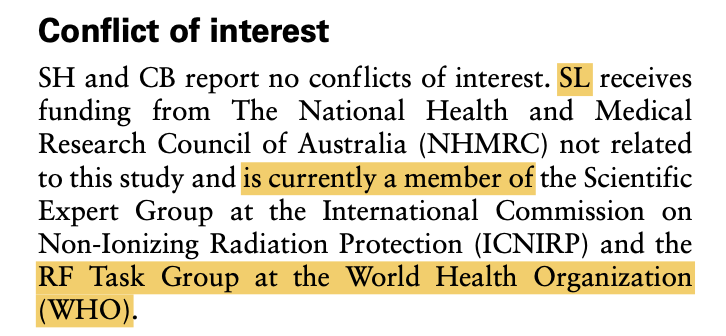 Source: Radiation Protection Dosimetry, 2023.
Source: Radiation Protection Dosimetry, 2023.
In contrast, ARPANSA waited until last week to make a formal announcement of her appointment. A press release was posted on the ARPANSA website on April 13.
Information Is Scarce
The EMF project has offered no further information about comments it may have received about those “considered for participation.” And, as noted earlier, the staff is unwilling to say anything more.
Early on, Sweden’s Lennart Hardell called for more transparency on the RF project at WHO. But nothing came of it.
Emilie van Deventer, the leader of the project, has not revealed when and by whom a final decision was made on the Task Group’s membership —nor when members were notified of their appointment. When asked about this timing by Microwave News in early March, she did not respond.
Van Deventer has also declined to say whether any outside observers were invited to attend the Task Group’s March meeting.
ICNIRP Still Rules RF at WHO
June 5, 2023
The latest chapter:
Even Closer Ties Between WHO and ICNIRP
December 11, 2023
Call for Retraction of One of the Systematic Reviews
July 10, 2024
Analysis of WHO RF Review on Pregnancy and Birth Outcomes
Another WHO Systematic Review Targeted
July 13, 2024
Within less than a week, a second systematic review commissioned by the WHO EMF Project has been challenged. Here again, the critics want the paper to be retracted.
FOOTNOTES
1. Van Deventer’s May 20, 2019, presentation is no longer publicly accessible. Note that it is dated September 17, 2018, on the title slide. This was most likely an error; one of her other slides (No.44) is from a news report published in mid-April 2019. Her slides from an October 10, 2018, presentation to the ITU are here.
2. The members of the core group: Maria Feychting (Sweden), Simon Mann (U.K.), Gunnhild Oftedal (Norway), Maria Rosaria Scarfi (Italy), Eric van Rongen (The Netherlands) and Denis Zmirou (France). See slide No.12, in Emilie van Deventer’s presentation at an ICNIRP Workshop in Cape Town, South Africa, May 2016. Van Deventer was also part of the group.
3. The other four members of the delegation: Dominique Belpomme (France), Igor Belyaev (Slovak Republic), Ernesto Burgio (Italy) and David Carpenter (U.S.).
4. In order of their signatures: they were: Henry Lai, (U.S.); Simona Carrubba (U.S.); Kjell Hansson Mild (Sweden); Semra Tepe Çam (Turkey); Alvaro Augusto de Salles, (Brazil); Alfonso Balmori (Spain); Samuel Milham (U.S.); Kavindra Kesari (Finland); Livio Giuliani, (Italy): Jerry Phillips (U.S.); David Carpenter (U.S.); Wenjun Sun (China); Lukas Margaritis (Greece); Carl Blackman (U.S.); Besarion Partsvania (Georgia); Hidetake Miyata (Japan); Marie-Claire Cammaerts (Belgium); Martin L. Pall (U.S.); and Paul Heroux (Canada).
5. The RF Guideline Development Group’s responsibilities are: